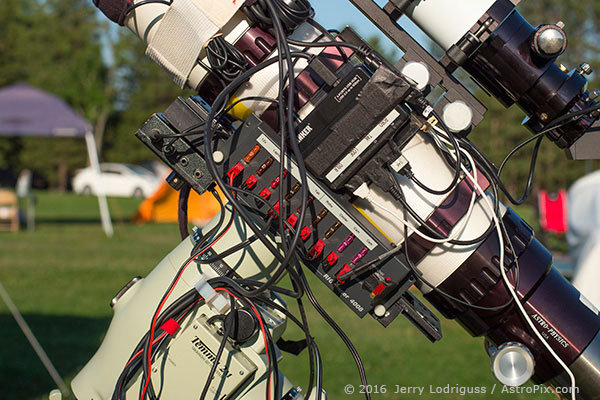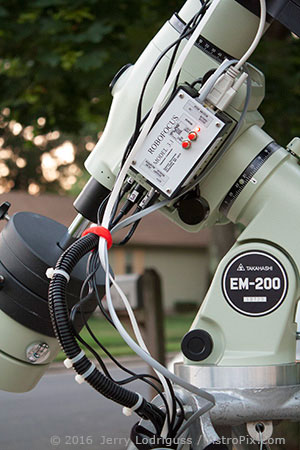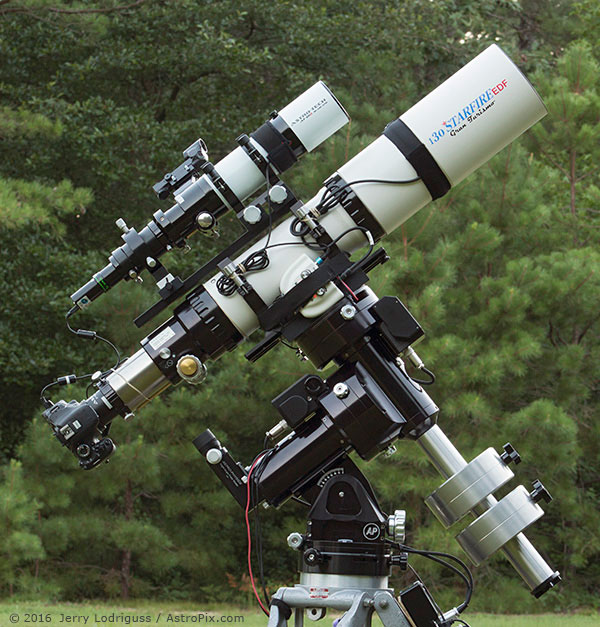Astronomy - Astrophotography: Cable Management
The art of astrophotography can quickly turn into the art of cable management. Learn how to tame the cable monster and get back to photographing the night sky.

The Simple Life
Only a couple of cables are needed when you’re starting out — one for power and one for the hand controller on the mount. Most cameras let you expose up to 30 seconds using the camera’s self-timer, so you won’t need a camera shutter release cable just yet.
Jerry Lodriguss
Only a couple of cables are needed when you’re starting out — one for power and one for the hand controller on the mount. Most cameras let you expose up to 30 seconds using the camera’s self-timer, so you won’t need a camera shutter release cable just yet.
Jerry Lodriguss
When we are first born, things are pretty simple. We begin with one cord attached to our mother. That cord is cut soon enough, but as we get older, we get more sophisticated and develop new attachments.
So it is with astrophotography. We start with one cable to power our mount; life is simple. We take pictures by pressing a shutter-release cable or using the self-timer. When we see the first results of a couple of seconds of exposure on the Orion Nebula, life is good. But then we get more sophisticated and start taking longer exposures of fainter objects.
For one, most of us have to take measures to combat dew. We add a dew heater, and a controller so it doesn’t run at full power continuously — only a small amount of heat keeps the glass above the dewpoint.
Next, we add an autoguider so we can shoot really long exposures with round stars. An autoguider usually requires an additional power cable, and a cable to go from the guider to your mount. Advanced models require a computer to control its functionsThat computer also needs a power cable, another cable connection between the autoguider and the computer, as well as another one connecting the computer and the mount.

When life gets more complicated, cables start to dangle. Here, cables for power and camera control just hang off the camera. This can cause trailed stars if the cables catch on anything, or if the wind blows and makes them sway in the breeze.
Jerry Lodriguss
Jerry Lodriguss
Then we figure that since the computer is at the scope already, we might as well run the camera with it — yet another cable that connects the imaging camera to your computer This offers some additional advantages between the guider and imaging camera that aren’t available when using stand-alone camera models, such as dithered guiding, a subject for a future column.
With every new gadget, the number of cables grows. Additional cables appear when you add a filter wheel, an electronic focuser, and even a powered USB hub if you’re shooting with multiple cameras.
Phew! Suddenly, life is complicated! We now have a bird’s nest of power and control wires running from batteries to computers to the mount and to the camera. I call this the “cable monster.” All of these cables need to be managed so they don’t catch on things or move when the wind blows, ruining our exposures.
Taming Astrophotography's "Cable Monster"
We could just get rid of most of the cables, but we want to keep our sophisticated toys, and with good reason – when mastered, they help us produce better images. So here are some alternatives.
The basic philosophy in all of these solutions is to anchor the cables at two points — one on the scope and one on the tripod or pier — and bundle all of the cables between them in a loop that can’t catch on anything.

Reduce the cable monster’s tangle by moving power and USB hubs to the top of the telescope, or on the mount. That way, most of them don’t move as the scope tracks the sky. Instead of a half dozen or more cables, only two — power and USB — need to move.
Jerry Lodriguss
Jerry Lodriguss

Loop and secure your cables, and remember to leave enough slack to let the scope move.
Jerry Lodriguss
Jerry Lodriguss
But first, take a good look at your rig. Is there any way to reduce the amount of cables coming off the scope?
For example, you can mount some accessories, such as a powered USB hub and your anti-dew controller right on top of your telescope tube. Then all you’d need is a single USB cable running from the computer to the hub and a single power cable from the battery to the dew zapper.
Next, bundle all of your cables together with flexible cable wraps or zip ties. Anchor the top to the declination plate or rings of your scope, and the bottom to a tripod leg.
Then create a loop with the bundled cables that is big enough so the mount can point anywhere it needs to without pulling on these cables. Anchor the other end of the loop securely to someplace near the base of the mount.
Test your cable setup by unlocking the clutches and swinging the scope around to different areas of the sky to make sure cables don’t snag as the scope tracks during your imaging session.
Of course, not every setup is this complicated or has this many cables, but in any event, don’t let the cable monster ruin your nights!

No comments:
Post a Comment